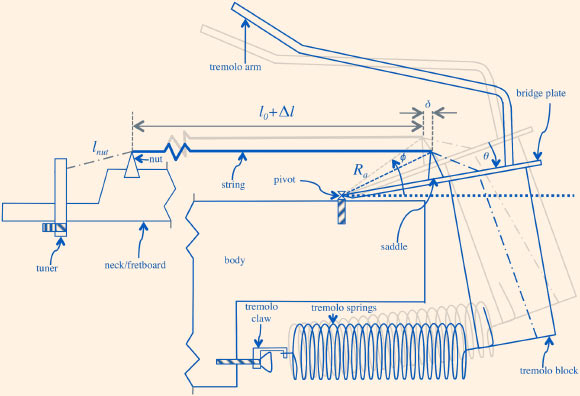An invention by University of St Andrews researcher Jonathan Kemp allows electric guitar strings to be balanced in sensitivity and feel in a way that has never been achieved before for an instrument with standard hardware.
“While string sets have been available before with balanced tensions, those strings have featured different sensitivities, with all strings bending through different pitch intervals when the player performs identical movements. The laws of physics prevent equalized feel between different plain steel strings,” Dr. Kemp said.
“With the new strings the properties are controlled to ensure that four of the strings (the plain G and the overwound D, A and low E strings) on a standard electric guitar bend through the same pitch intervals for identical player control changes, whether that be through conventional pitch bends (dragging the strings through a certain distance along a fret to increase tension) or through use of a tremolo/vibrato arm.”
“The clearest demonstration of this is through listening to chords played on these strings during tremolo arm use.”

Cross-section of an electric guitar showing the operation of a tremolo system: the vibrating length (l0 + Δl) of the tuned up string is shown as a thick grey line; when the tremolo arm is raised (away from the body), the bridge plate, saddle and tremolo block are all rotated by an angle of θ around the pivot; the resulting sounding length, shown as a thick black line, is increased by a distance δ. Image credit: J.A. Kemp, doi: 10.1371/journal.pone.0184803.
The new strings mean that chord bends can be achieved that have not been possible before on standard guitars, such as Fender Stratocasters with standard tremolo units or guitars with the Floyd Rose locking tremolo system.
According to the researcher, all electric guitar players can benefit from the new strings — not just users of tremolo arms — as the optimized sensitivity means that the D string is no longer more difficult to bend than its neighbors and the low E string no longer goes more sharp than the rest of the strings when played hard. Temperature related tuning problems are also reduced.
“The new strings are as cheap to construct as existing designs and all in all this amounts to a breakthrough for electric guitar performance and one that doesn’t require any expensive changes to players’ existing instruments,” he said.
“The new strings are awesome fun and provide fantastic new creative opportunities for your whammy bar,” said guitarist Mark McGuigan of Mastertheguitar.co.uk.
Dr. Kemp’s invention is described in the journal PLoS ONE.
_____
J.A. Kemp. 2017. The physics of unwound and wound strings on the electric guitar applied to the pitch intervals produced by tremolo/vibrato arm systems. PLoS ONE 12 (9): e0184803; doi: 10.1371/journal.pone.0184803








